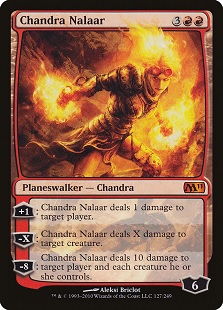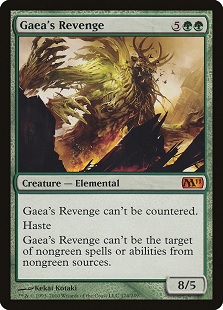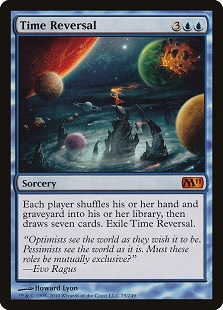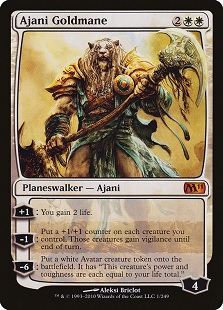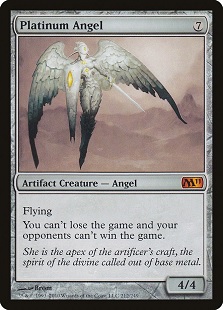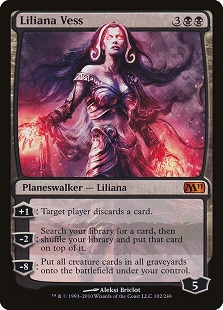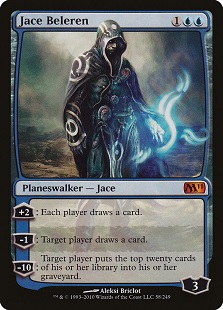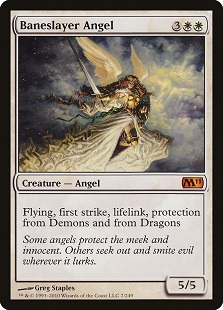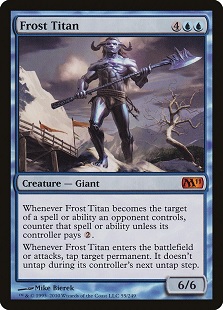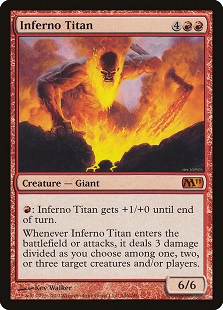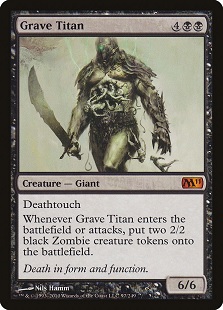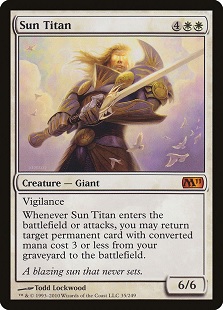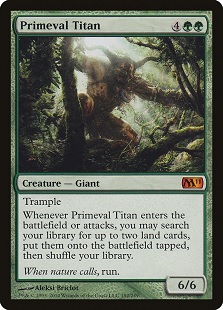Magic 2011 holds a somewhat special place in my heart because it was the first prerelease I played after I came back to Magic following a couple year hiatus. I got my Sun Titan promo and went to town playing as much Limited as I could and building decks however I could. Rise of the Eldrazi brought me back, but this was the set that kept me around, and boy were there some outstanding cards in both the rare and mythic slots. Today, I want to run through the mythics of the set and see what's hot and what's not. You'll see many repeats from my Magic 2010 list here, but you might be surprised at where some of them end up by comparison. Let's jump in and see how things shook out!
15. Chandra Nalaar
Chandra Nalaar was right around the very bottom of the Magic 2010 list and only didn't make number 15 because Xathrid Demon was just that bad. Chandra, however, is still just as bad as ever here and feels so unfun to use. At least some of the other low rank cards here tried to do something different and strong, even if it was boring and couldn't make the cut in the long run.
14. Demon of Death's Gate
This is one big demon and getting to cast it for "free" seemed like a great deal at the time - certainly a far cry better than Xathrid Demon in the previous core set. Unfortunately, needing to sacrifice three creatures as well as lose nearly a third of your life in Constructed is a dealbreaker, and in Commander the removal is strong enough to remove the demon with ease. That puts a lot of risk on this card on top of a lot of setup to even make it work in the first place. As it happens, given that this set also featured the Titan cycle, this was doomed from the start. Why go for this when you could just slam Grave Titan and be happy about it?
13. Gaea's Revenge
Much like Demon of Death's Gate, Gaea's Revenge was ultimately doomed by the simultaneous arrival of the Titan cycle. Would you ever want this over a Primeval Titan? Absolutely not. It was a bit more reliable than Demon of Death's Gate, but it was similarly by and large just a big French vanilla beater and was therefore quite boring. In its day it was a solid top end play in Commander and it made for a reasonable sideboard play to help deal with Control matchups that Prime Time had a hard time fighting through. However, when taken as a whole, it always felt like the least exciting thing you could be doing in Green and it's only gotten worse as time has gone on.
12. Time Reversal
Time Reversal is meant to be another instance of a modern day update on a classic piece of the Power Nine, like how Time Warp is a more appropriately priced Time Walk. Unfortunately, Timetwister is generally considered the worst of the Power Nine (though still quite potent in the right deck) and at five mana, it's just not good enough. Worse still, it exiles after use, making it hard to utilize repeatedly like you would with Timetwister. The card was seen as neat but ultimately fizzled in the long run outside the occasional Commander deck or odd brew trying it out. Even though it was a dud in a playability sense, it was far more exciting than big semi-vanilla creatures.
11. Ajani Goldmane
Talking about Ajani Goldmane in Magic 2010 was kind of weird. He always felt like a rock-solid card but never felt like you ever really saw him anywhere. He wasn't a big Constructed player and only offered a little bit of play in certain Commander decks, but how the card actually played always felt solid enough that it had uses, unlike the borderline unplayable Chandra Nalaar. Here, he's pretty much in the same boat: not particularly great, but firmly middle of the road. He did see some minor play in Tempered Steel decks as an extra pump spell, but both rarely and in small numbers.
10. Platinum Angel
Seeing Platinum Angel at mythic in Magic 2010 just felt so right, which is why it ranked highly on that list. It had already been reprinted in Tenth Edition at rare before, but it just made so much sense as a mythic that it deserved the high placing on that list because it felt like the perfect encapsulation of what that rarity meant. By the time Magic 2011 rolled around, however, it had been reprinted three core sets in a row and it was beginning to lose a bit of its sheen. Any new player would still have their minds blown by it, but for everyone else, it was time for something a little fresher.
9. Liliana Vess
Liliana Vess was and is a classic Commander card. She's lost a bit of her luster but back in the day, if you were playing a Black deck, it was hard to not justify playing her. It also happened that in this era, she saw a decent amount of play, getting utilized in the Dimir Control decks of the era, albeit in small numbers. Still, this was infinitely more play than she saw in 2009 and the early part of 2010 following her reprint in Magic 2010, allowing her to continue being a defining part of the Magic environment of the era.
8. Garruk Wildspeaker
Ramping and making 3/3 tokens never felt so good as Garruk Wildspeaker makes it seem. With Magic 2011, Garruk continued to be an absolute powerhouse, and did so quite potently in Standard as well, seeing play in ![]()
![]()
![]() (now Temur) Control lists to help push out big finishers like Inferno Titan and Avenger of Zendikar or else just make a constant stream of 3/3s to help give you strong attackers and potent blockers. This would be the last time we'd see this card in Standard, but what a bang to go out with.
(now Temur) Control lists to help push out big finishers like Inferno Titan and Avenger of Zendikar or else just make a constant stream of 3/3s to help give you strong attackers and potent blockers. This would be the last time we'd see this card in Standard, but what a bang to go out with.
7. Jace Beleren
Jace Beleren is the first instance we really see among these mythic ranking lists of cards that actually go higher among the rankings. With Magic 2010, Jace wasn't the most exciting card and often felt like more of a roleplayer and a great casual card. Since that set came out, though, Worldwake came around and with it brought Jace, the Mind Sculptor. Thanks to the way planeswalker and legendary rules worked at the time, as well as a lack of actual planeswalker removal, playing a Jace Beleren offered a cheap way to effectively kill Jace, the Mind Sculptor. It just so happens that the card was also pretty good at helping you draw cards for yourself, so even if it wasn't playing the removal role, it was still a good card in its own right. This was Jace Beleren's true moment to shine and he did so spectacularly.
6. Baneslayer Angel
If you've read a lot of competitive theory and discussion over the last decade or so, you've probably heard the term "Baneslayers and Mulldrifters." The idea is that a Baneslayer is something so big and threatening it's worth playing even if you have to rely on it sticking around a turn to get use out of it, whereas a Mulldrifter gives you strong enough value that even if it doesn't stick around, it did its job. This set is a perfect encapsulation of this, as the famous Walletslayer itself didn't necessarily get worse in the span of a year, but Magic 2011 brought with it the five Titans - each of which are defining examples of Mulldrifters. As a result, they minimized the impact of Baneslayer Angel on its second printing, but it turns out the card was still quite a powerhouse that needed to be respected.
5. Frost Titan
I think most people would argue which titans are the best and which are the worst depending on a lot of various metrics, but make no mistake: all of them were excellent. Still, there had to be a worst and Frost Titan is my pick for that title. Tapping down one creature for a turn is rather pitiful compared to getting to Arc Lightning, making more creatures, geting non-basic lands, or recurring any small permanent. The low impact has really put a damper on the long-term utility of the card, making it hard to justify even in a format like Commander. At the time it released, though, it was a house in Standard, just like the other Titans, and had a solid role in the format of the time. Even as the worst in one of the best cycles of all time, it still feels like a firm 8 out of 10, meaning it's no slouch by a longshot.
4. Inferno Titan
Inferno Titan always seems like one of the more mediocre titans and more than ever feels like a janky bulk rare. Better value creatures have simply eclipsed it and it's hard to justify over the myriad of other big monstrosities by today's standards. Back in 2010 and 2011, though? Inferno Titan was an absolute force to be reckoned with. It ended games fast with incredible efficiency once it hit the board and was fantastic in the early 2010s era of Commander as a stellar top-end finisher before the modern day designs would overthrow it.
3. Grave Titan
Make two tokens, then make more. Grave Titan is just the card that keeps on giving. Two other titans provide higher amounts of value in a general sense, but this one produces so many tokens it often overwhelms opponents completely. Even if you can kill it, the creature frequently makes its biggest splashes in Reanimator decks, meaning it just keeps coming back for more and bringing even more tokens with it. Just look at the new Revenant Recon precon from Murders at Karlov Manor for an example and you'll see what I mean. The card saw no shortage of Standard play, Cube play, Commander play, and even a little bit in Modern and Legacy from time to time. It's simple, but is always a force to be reckoned with.
2. Sun Titan
In terms of sheer monetary value, Grave Titan easily has Sun Titan beat out. That's probably a reasonable barometer to some, but in reality the only reason Sun Titan doesn't go for more is just how much it's been reprinted ever since. It's an absolute Commander all-star, bringing back whatever you need and allowing you to get up to some serious shenanigans in the process. Even in Standard it was a key player of the Unburial Rites Solar Flare deck of the Innistrad era. It might not be worth a whole lot today, but its utility and play in the game is second only to one here.
1. Primeval Titan
Right out of the gate, Primeval Titan brought with it a truly monstrous impact on the game. Without question, it was far and away the best of the titan cycle and became one of the defining cards of numerous formats. At the time of release, it became THE thing to do in Commander, to the point that it warped games and led to a ban. In Standard it was a lead player in Valakut Ramp and Wolf Run Ramp. Even in formats like Modern and Legacy it made huge splashes thanks to decks like Titan Shift, Amulet Titan, and Twelve-Post. It all started here, and has continued to be one of the greatest creatures of all time.
Paige Smith
Twitter: @TheMaverickGal
Twitch: twitch.tv/themaverickgirl
YouTube: TheMaverickGal
















